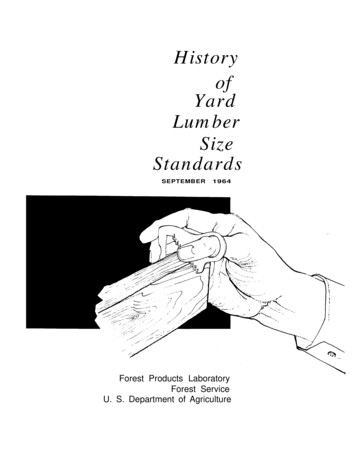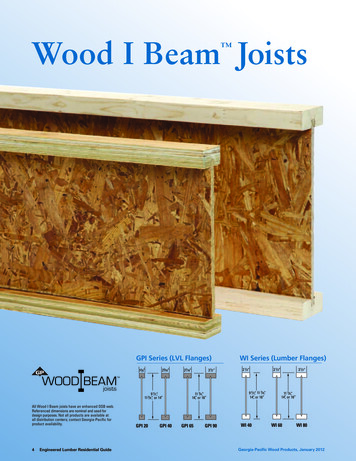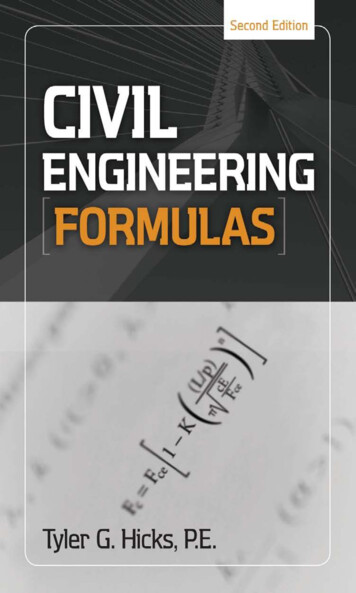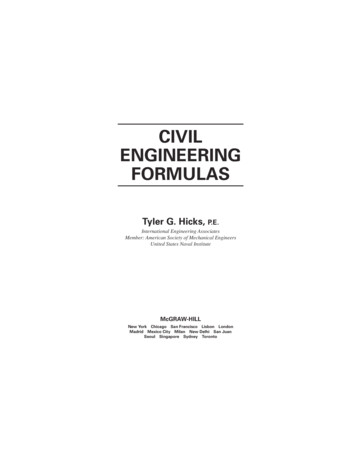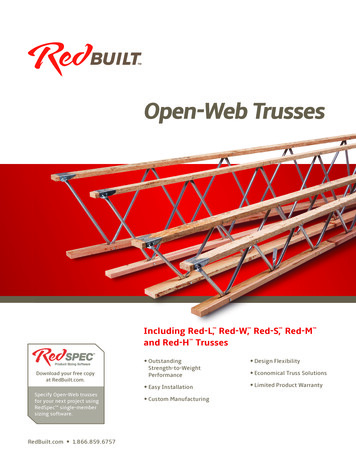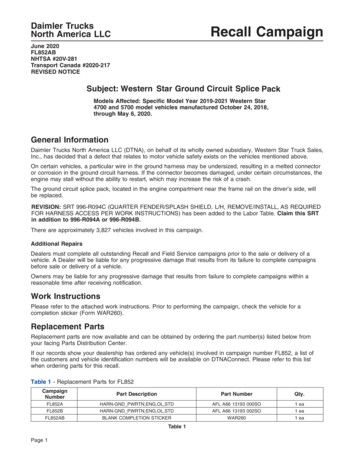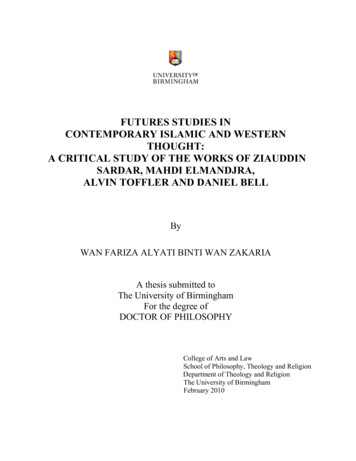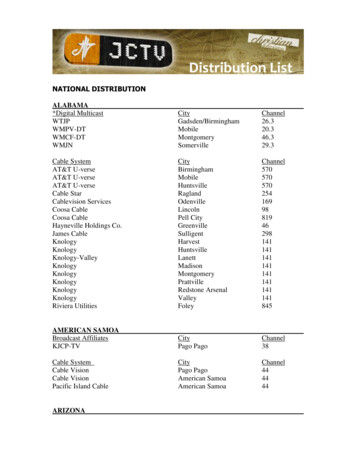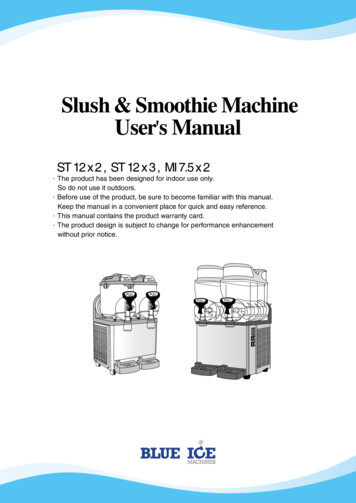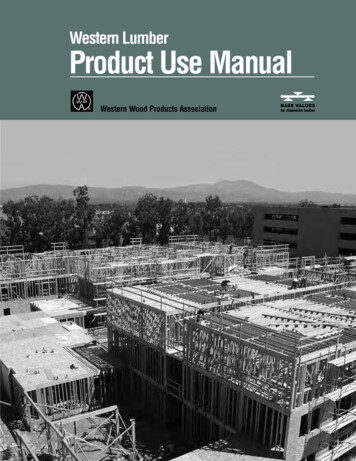
Transcription
Western LumberProduct Use ManualWestern Wood Products AssociationBASE VALUESfor dimension lumber
Western Lumber Product Use ManualABOUT WWPAWestern Wood Products Association (WWPA) provides lumbergrading and technical support services for the Western lumberproducts of its member mills. Approved by the Board of Review of theAmerican Lumber Standard Committee, Inc. (ALSC), which operatesunder the jurisdiction of the U.S. Department of Commerce, WWPA iscertified as a lumber inspection and rules-writing agency.WWPA is approved to provide mill supervisory services and to gradeand inspect lumber according to its own Western Lumber GradingRules, the West Coast Lumber Inspection Bureau’s (WCLIB) WestCoast Standard Grading Rules, the Pacific Lumber InspectionBureau’s (PLIB) Export R List Rules, the rules of the Redwood Inspection Service, the National Lumber Grades Authority’s StandardGrading Rules for Canadian Lumber, Eastern White Pine CommonBoard Grades of the Northeastern Lumber Manufacturers Association’sStandard Grading Rules for Northeastern Lumber, and theNational Grading Rule portion of the Southern Pine InspectionBureau Rules. In addition, WWPA is approved to provide quality control and certification services for machine stress-rated (MSR) lumberand structural-glued lumber products in all Western species and heattreatment audit services under all ALSC recognized rules.WWPA gradestamped National Grade Rule (NGR) Dimension lumber is recognized by the Japanese Ministry of Land, Infrastructure andTransportation for use in wood frame construction.WWPA is certified to train mill graders to grade structural lumber tothe Australian rules. In addition, WWPA gradestamped structural lumber is accepted for use in wood construction in Australia.Lumber buyers may look to WWPA’s registered grade mark for theassurance that lumber will consistently meet grade specifications andperformance standards.The Association maintains a team of Lumber Inspectors to monitorlumber grading and product quality control in its member mills and toprovide mill inspection and grading performance reports, lumber gradertraining and incentive programs, MSR and glued products standards,resource recovery and mill efficiency studies.In addition, WWPA provides technical and product support servicesand information on Western lumber end uses for lumber buyersthroughout the world and publishes a variety of statistical reports onWestern lumber production, distribution and consumption.A host of Western lumber technical and product information is available online on the WWPA web site at www.wwpa.org. The site featuresan Online Lumber Technical Guide, an interactive Western LumberBuyers Guide and digital versions of a number of WWPA literature titles.DISCLAIMERInformation in this manual has been obtained by Western WoodProducts Association from sources believed to be true. However,neither WWPA or its members, nor the authors guarantee the accuracyof any information published herein and these parties are not responsible for any errors, omissions or damages arising out of or relating to itsuse. This document is published with the understanding that WWPA,its members and the authors are supplying information, but are notattempting to render engineering or other professional services.TABLE OF CONTENTSABOUT WWPAI.WESTERN LUMBER SPECIES AND GRADESWestern Woods RegionWestern LumberSpecies GroupingsMarketing CategoriesGrade CategoriesWWPA Grade StampsLumber Design ValuesFraming LumberII.233344555WESTERN LUMBER GRADES AND USESFraming LumberDimension LumberBASE VALUES for Western Dimension LumberAdjustment Factors for BASE VALUESAdjustments Checklist for Dimension LumberUsing BASE VALUESBASE VALUE EquationsDimension Lumber Grades/End UsesStructural-Glued Lumber ProductsAdditional Adjustments for Conditions of UseSpecial Dimension LumberStructural Decking Grades/End Uses and Design ValuesMSR Lumber Grades/End Uses and Design ValuesTimber GradesBeams and Stringers Design ValuesPosts and Timbers Design ValuesAdjustment FactorsMechanical Properties IllustratedStandard SizesSpan TablesSection PropertiesSpecifying Information1111121213141617Appearance LumberBoard LumberGrades/End UsesRun-to-pattern ProductsRadius-edged Patio DeckingStandard SizesSpecifying Finish Carpentry MaterialsMoisture Content InformationSiding or Paneling Specification Checklist18181919202020Industrial LumberGrade ClassificationsStructural ProductsRemanufacturing ProductsNon-structural ProductsStandard SizesSpecifying InformationIndustrial Lumber Specification Checklist21212222222267788889910III. RELATIVE PROPERTIES OF WESTERN SPECIESWestern Wood Products Associatione-mail: info@wwpa.orgweb site: www.wwpa.org WWPA 20082Dimensional StabilityFlame-Spread Ratings and Smoke-Developed IndicesWeight per Linear FootSpecific GravityThermal Conductivity2323232424
Western Lumber Species and GradesWESTERN WOODS REGIONSPECIES GROUPINGSThe West features a rich diversity of timber, with 231 million acres offorestland throughout the region. Of that acreage, just 126 million acresis available for commercial timber production and the remaining isreserved for wilderness, watershed protection, wildlife, parks and othernon-commercial activities.More than half of this timberland is owned by the federal government, which is managed by the U.S. Forest Service and Bureau ofLand Management. The forest industry and other private landholdersown 34 percent of this land and state and other public agenciesaccount for the remaining 10 percent.Recognizing the need for proper management and protection of theWest's forest resources, timber companies and public agencies developed the first of the western forestland management laws in the early1940s. The Oregon Forest Conservation Act of 1941 provided theframework for laws such as the Oregon Forest Practices Act, adoptedin 1971. Other states, including Washington, California and Idaho, haveadopted similar forest practices laws.The evolution of these laws and improvements in forest management practices in the West has provided the foundation for some ofthe toughest, most progressive forest laws in the world. Ongoing private and publicly funded research has led to improvements in streamand watershed protection, fish and wildlife habitat, and other forest values important to society. The forest management practices used in theWest today are designed to improve the whole forest ecosystem ratherthan for specific values.While the federal government is the largest timberland owner in theWest, the national forests supply just 7 percent of the timberprocessed by mills in the region today. The forest industry and otherprivate owners account for some 78 percent of the timber cut intolumber.Yet, according to the U.S. Department of Agriculture, private forestlands declined less than 0.5 percent from 1997 to 2002 while federalforest lands increased by 1 percent. Thanks to forest managementregulations and efforts by the forest industry and other privatelandowners to practice sustainable forestry, the forests of the West willcontinue to supply the country’s wood needs far into the future.There are more than 15 commercially important Western softwood species. The lumber from several of the Western softwoodspecies shares performance properties and is similar enough inappearance that many species are grouped together into‘‘Marketing Categories.’’ The species within these categories areoften harvested, manufactured and sold interchangeably in themarketplace.Western lumber may be bought, sold and specified as separatespecies or according to the species groups, or ‘‘MarketingCategories,’’ shown on the map below and outlined on thefollowing page.SUSTAINABLE WESTERN LUMBERIn the West, federal regulations, state forest practices acts and bestmanagement practices are among the most rigorous in the world.Forest products companies are also taking additional steps to assurethat harvesting and forestry practices are being conducted sustainably.More than 10 million acres of timberland in the West have receivedindependent, third-party certification though the Sustainable ForestryInitiative (SFI). Also, nearly 2.5 million acres of Western timberland arecertified through the Forest Stewardship Council (FSC), with productsfrom this timber marked to assure buyers that they come from foreststhat are managed to meet the social, economic and ecological needsof present and future generations.These activities demonstrate the Western lumber industry’s commitment to deliver environmentally friendly, sustainable forest products tothe market now and in perpetuity.Cedar, Hemlock, Spruce, DouglasFir, Pine and True Firs with Redwoodalong the California CoastTrue Firs, Spruce, Douglas Fir and PinePine and Douglas FirDouglas FirTrue Firs and Douglas FirMixed ConifersPonderosa Pine and Lodgepole Pine3
Western Lumber Species and GradesWESTERN LUMBER SPECIES MARKETING CATEGORIESStandard SpeciesCombinationsWestern Softwood SpeciesAlternate SpeciesCombinationsDouglas Fir— Pseudotsuga menziesiiWHITE Noble FirCalifornia Red FirFIR Grand FirDouglas Fir-LarchWestern Larch— Larix occidentalisDouglas Fir-SouthPacific Silver FirWhite FirDouglas Fir-South— Pseudotsuga menziesii(Grown in AZ, CO, NV, NM and UT)Engelmann SpruceLodgepole PineWestern Hemlock— Tsuga heterophyllaHem-FirWesternWoodsNoble Fir— Abies proceraCalifornia Red Fir—Abies magnificaGrand Fir— Abies g randisPacifi c Silver Fir—Abies amabilisWhite Fir— Abies concolorAlpine FirHem-FirSitka Spruce— Picea sitchensisSpruce-Pine-Fir(South)Engelmann Spruce—Picea engelmanniiLodgepole Pine— Pinus contortaAlpine Fir— Abies lasiocarpa(or Subalpine Fir)Ponderosa Pine— Pinus ponderosaSugar Pine— Pinus lambertianaWhiteWoods(an ycombinationof theWester ntrue firs,spruces,hemlocksor pines)Ponderosa PineSugar PineEngelmann SpruceAlpine FirEngelmann SpruceLodgepole PineAlpine FirPonderosa PineLodgepole PineIdaho White Pine— Pinus monticola(or W estern White Pine)Mountain Hemlock— Tsuga mertensianaIncense Cedar— Libocedrus decurrensWestern CedarsWestern Red Cedar— Thuja plicataPort Orford Cedar— Chamaecyparis lawsonianaAlaskan Cedar— Chamaecyparis nootkatensisGRADE CATEGORIESWestern solid-sawn lumber is grouped into three broad categories:framing (or structural) lumber, which is graded for strength; appearancelumber, which is not graded for strength; and industrial (or factory)lumber, which is generally graded for specific end uses or forremanufacturing and recovery purposes.Framing lumber includes the grades intended for structuralapplications in both conventional and pre-engineered framing systems.Western species structural lumber is manufactured primarily fromsecond- and third-growth softwoods and graded, either visually ormechanically, on the basis of its strength; each species and grade hasan assigned design value. General classifications include: Dimension lumber grades Special Dimension lumber grades Timber gradesDesign values for Dimension lumber are published as BASEVALUES which must be adjusted for size as well as conditions of use.Refer to pages 5 to 17.Appearance lumber includes a variety of non-structural gradesintended for applications where strength is not the primary consideration. Appearance grade Western lumber is manufactured primarily fromolder (not ‘‘old growth’’) and second-growth softwood trees. Many of4the products in this category are often run-to-pattern for paneling andsiding applications. General classifications include: High-quality Appearance grades(Selects, Finish and Special Western Red Cedar Grades) General purpose Board grades(Commons under WWPA Rules andAlternate Board Grades under WCLIB Rules)Radius-edgedPatio Decking grades (Patio 1 and Patio 2)Refer to pages 18 to 20.Industrial lumber includes both structural and non-structural gradesintended for specific applications. General classifications include: Structural grades(Mining Timbers, Scaffold Plank, Foundation lumber,Stress-Rated Boards)Factoryand Shop grades (non-structural grades intended for cut up and remanufacturing) Non-structural grades(Gutter, Picket, Lath, Batten, Stepping)Refer to pages 21 and 22.
Framing LumberWWPA GRADE STAMPSFRAMING LUMBERGrading practices of WWPA mills are closely supervised by theAssociation’s field team of Lumber Inspectors to assure uniformity andconformance to the Western Lumber Grading Rules. These rulesestablish standards for size and levels of quality in conformance with theAmerican Softwood Lumber Standard PS 20, which can be viewedonline at: http://ts.nist.gov/docvpsThe Grading Rules provide the specifier with a dependable measurefor determining the quality of lumber. Western lumber grades may beassigned visually or mechanically.The building codes require that grade-marked lumber be used forstructural applications. If practical, appearance grades such as Selectsand Commons used for siding, paneling and soffits, may be specifiedend stamped. Most grade stamps, except those for rough lumber orheavy timbers, contain the five basic elements shown below:a. WWPA Certification Mark: Certifies Association quality supervision.is a registered trademark.(b)(c)b. Mill Identification: Firm name,brand or assigned mill number. A(d)WWPA mill number list is available(a)(e)online at www.wwpa.org/millno.htm.c. Grade Designation: Grade name, number or abbreviation.d. Species Identification: Indicates species by individual species orspecies combination. Other species identification marks are shownin the species list on page 4.e. Condition of Seasoning: Indicates condition of seasoning at the timeof surfacing–S-GRN- over 19% moisture content (unseasoned)S-DRY, KD or KD HT - 19% maximum moisture contentMC15 or KD15- 15% maximum moisture contentThe general classifications of framing lumber are Dimension, SpecialDimension and Timbers. The lumber grades within these classifications are intended for structural applications in load-bearing situations.The design values for Dimension lumber in Table 1 are published asBASE VALUES. BASE VALUES are constants that are applied to eachgrade in a particular species grouping. BASE VALUES must be adjusted for size, using the SIZE-ADJUSTMENT FACTORS in Table A.Design values in Table 3 are published in a SIZE-ADJUSTED FORMAT,and no size adjustment is necessary. All design values (in Tables 1-5)must be adjusted for conditions of use (Tables B-K) as appropriate.Refer to pages 7-9 for more information on using BASE VALUES. Thechecklists, after each classification of lumber, serve as reminders as towhen and how to apply adjustments to the numbers in each table ofdesign values.RKD HT LUMBER GRADE STAMPA KD HT mark, indicating the wood has been kiln dried (KD) and heattreated (HT), is used to meet international regulations for wood pallet andpackaging materials. The mark indicates lumber has been dried to amaximum moisture content of 19 percent or less, and was heat-treatedto a lumber core temperature of 56oC for a minimum of 30 minutes.For structural framing applications, including Metal Plate Connected(MPC) wood trusses, the KD HT mark can be considered the same as surfaced dry (S-DRY) and KD.LUMBER DESIGN VALUESDesign values for North American softwood structural lumber aredetermined in accordance with ASTM standards based on clear-woodtests and tests of graded lumber pieces. The applicable standards,based on results of tests conducted in cooperation with the USDAForest Products Laboratory, are ASTM Standards D 2555 and D 245for clear-wood, and D 1990 for graded lumber specimens. Refer toSections 100.00 to 180.00 of the Western Lumber Grading Rules foradditional information.Design values are published in the Western Lumber Grading Rules,incorporated into the Supplement to the National Design Specificationfor Wood Construction (NDS ), and are shown on the followingpages of this publication; for NGR Dimension lumber in Table 1 (page 6)and for Timbers in Tables 4 and 5 (page 11). These design values arerecognized by the model building codes. For any alternate speciescombinations (other than the standard species combinations) thespecies of lowest assigned design value governs the combination.Mechanical Properties - Lumber strength properties are assigned tofive basic properties: fiber stress in bending (Fb ), tension parallel tograin (Ft ), horizontal shear (Fv ), compression perpendicular to grain(Fc ) and compression parallel to grain (Fc). The modulus of elasticity(E or MOE) is a ratio of the amount a piece of lumber will deflect inproportion to an applied load. It is a measurement of stiffness and nota strength property. Emin is the modulus of elasticity for beam and column stability calculations. Refer to pages 12 and 13 for a descriptionof these properties.Western lumber design values are for use in all normal constructiondesign. Higher or lower design values may be used to meet specialstructural requirements. Standard ASTM reductions have been madeto the strength values to account for safety and duration of load. TheNational Design Specification for Wood Construction (NDS ), published by the American Forest & Paper Association, www.awc.org,1111 19th Street, NW, Eighth Floor, Washington, DC 20036, sets forthdesign methods for structural applications.Moisture Content and Heat Treating - Any of the abbreviations,S-GRN, HT, S-DRY, KD, KD HT, MC15, or KD15 may be found in agrade stamp to denote the moisture content (MC) of lumber at thetime of surfacing. Designations are explained in the left column.Unseasoned (S-GRN) lumber is manufactured oversized so thatwhen it reaches 19% MC it will be approximately the same size as thedry size. Therefore, when unseasoned lumber is shipped, the samedesign values that are assigned and used for dry lumber also apply toS-GRN lumber.Heat Treated (HT) lumber is lumber that has been placed in a closedchamber and heat added until the lumber achieves a minimum coretemperature of 56oC for a minimum of 30 minutes.The word ‘‘DRY’’ indicates that a product was either kiln or air driedto a maximum moisture content of 19%. Kiln-dried (KD) lumber is lumber that has been seasoned in a chamber to a pre-determined moisture content by applying heat.Kiln Dried Heat Treated (KD HT) lumber is lumber that has beenplaced in a closed chamber and heat added until the lumber achievesa minimum core temperature of 56oC for a minimum of 30 minutesand which is dried to a maximum moisture content of 19% or less.Framing lumber 2" and less in thickness may be seasoned to amoisture content of 19% or less, with the indication ‘‘S-DRY’’ or ‘‘KD’’on the grade stamp. Surfaced framing lumber over 2" in thickness istypically shipped unseasoned and indicated ‘‘S-GRN’’ on the gradestamp. Regional market conditions dictate the availability of dry orunseasoned material.5
Framing LumberBASE VALUES FOR WESTERN DIMENSION LUMBER 1Table 12Nominal Sizes: 2″ to 4″ thick by 2″ and widerUse with appropriate Adjustments, Tables A through GGrades described in Western Lumber Grading Rules, Sections 40.00, 41.00, 42.00 and 62.00. Also Stress-Rated Boards, see Section 30.60Speciesor GroupDouglas FirLarchDouglas FirWestern LarchDouglas FirSouthDouglas Fir-South(grown in AZ, CO,NV, NM and UT)Hem-FirWestern HemlockNoble FirCalifornia Red FirGrand FirPacific Silver FirWhite FirSpruce-Pine-Fir(South)Western Species:Engelmann SpruceSitka SpruceWhite SpruceLodgepole PineWestern CedarsWestern Red CedarIncense CedarPort Orford CedarAlaskan CedarWestern Woods(and White Woods 4)Any of the species inthe first four speciesgroups above plus anyor all of the following:Idaho White PinePonderosa PineSugar PineAlpine FirMountain Hemlock16ExtremeFiber Stressin BendingGradeSelect StructuralNo. 1 & Btr.No. 1No. 2No. 3ConstructionStandardUtilityStudSelect StructuralNo. 1No. 2No. 3ConstructionStandardUtilityStudSelect StructuralNo. 1 & Btr.No. 1No. 2No. 3ConstructionStandardUtilityStudSelect StructuralNo. 1No. 2No. 3ConstructionStandardUtilityStudSelect StructuralNo. 1No. 2No. 3ConstructionStandardUtilityStudSelect StructuralNo. 1No. 2No. 3ConstructionStandardUtilityStudSingle Member 75425200525CompressionTensionParallelto GrainFtHorizontal3ShearFvPerpendicularFc Parallelto 0,000900,000Modulus 00290,000330,000Design values in pounds per square inch.2Standard surfaced sizes are tabulated in Table 13.3All horizontal shear values are assigned in accordance with ASTM standards, which include a reduction to compensate for any degree of shake, check or split that might develop in a piece.4White Woods species group includes any species or combination of true firs, spruces, hemlocks or pines. Design values are the same as those assigned to Western Woods.
Framing LumberADJUSTMENT FACTORS FOR BASE VALUESDURATION OF LOAD ADJUSTMENT (CD )Table CApply to size-adjusted valuesWood has the property of carrying substantially greater maximum loads forshort durations than for long durations of loading. Tabulated design values applyto normal load duration. (Factors do not apply to MOE or Fc )Table ASIZE FACTORS (CF)Apply to Dimension lumber BASE VALUESLoad DurationFbNominalWidth(depth)Grades2ⴖ & 3ⴖ4ⴖthickthicknominal nominalFtFcOtherProperties2″, 3″, & 4″5″6″8″10″12″14″ & 1.01.01.01.0CONSTRUCTION2″, 3″, & 4″& STANDARD1.01.01.01.01.02″ & 3″4″0.41.0—1.00.41.00.61.01.01.02″, 3″, & 4″5″ & 6″1.11.01.11.01.11.01.051.01.01.08″ & widerUse No.3 grade Base Values and Size FactorsSELECTSTRUCTURAL,NO.1 & BTR.,NO.1, NO.2& NO.3UTILITYSTUDFactorPermanentTen Years (Normal Load)Two Months (Snow Load)Seven DayTen Minutes (Wind and Earthquake Loads)Impact0.91.01.151.251.62.0Confirm load requirements with local codes.HORIZONTAL SHEAR DESIGN VALUESHorizontal shear values published in Tables 1, 3, 4 and 5 are basedupon the maximum degree of shake, check or split that might developin a piece. Shear design values for lumber have been approved by theAmerican Lumber Standard Committee, Inc.Design provisions, including requirements for shear design of lumber, are published by the American Forest & Paper Association(AF&PA) in the National Design Specification for Wood Construction (NDS ), an ANSI national consensus standard.DIMENSION LUMBERSizes/Design Values - Dimension lumber includes products that arenominal 2" to 4" in thickness by 2" and wider. It is available in thegrades listed in Table 1 (page 6) with assigned design values publishedas BASE VALUES.Dimension lumber BASE VALUES must be adjusted for size as wellas conditions of use. Adjust the BASE VALUE (Table 1, page 6)according to the size factor (Table A, page 7) before adjusting for conditions of use.Single member, size-adjusted fiber stress in bending (Fb ) designvalue is for use where the strength of an individual piece, such as asmall beam or post, is or may be responsible for carrying a specificdesign load. Repetitive member use is handled through an adjustmentfactor (Table B, page 7).Table BREPETITIVE MEMBER FACTOR (Cr )Apply to size-adjusted FbWhere lumber is used repetitively, such as for joists,studs, rafters, and decking, the pieces side by sideshare the load and the strength of the entireassembly is enhanced. Therefore, where three ormore members are adjacent or are not more than24″ on center and are joined by floor, roof, or otherload distributing elements, the Fb value can beincreased 1.15 for repetitive member use.RepetitiveMember UseFb ⴛ 1.15Checklist 1ADJUSTMENTS FOR DIMENSION LUMBERThe boxes in the checklist below indicate when and how to apply adjustments (Tables A–G) to the BASE VALUES in Table 1.BaseValuesBaseValueFbFtFvFc FcE, EminTable 1page 6xAdjustment FactorsxRepetitiveMemberCrSizeCF x xDurationof LoadCD xFlatUseCfuxCompressionPerpendicularto GrainCc Table A Table Bpage 7Table C Design ValuesIncising, Wet Use,Fire-Retardant 1,High-Temperature Ci CM CR C tDesign ValueSpecial Use FactorsxTable DTable Epage 9x F ′b BendingF ′t TensionF ′v ShearF c′ Compression Perpendicular to GrainF ′c Compression Parallel to GrainE ′, E ′min Modulus of ElasticityCh. 2 of NDSNational Design Specificationfor Wood Construction1 Adjustments for fire-retardant treatment shall be provided by the manufacturer providing the treatment.7
Framing LumberUsing BASE VALUES - Dimension lumber values are published asBASE VALUES in Table 1, page 6. BASE VALUES must first beadjusted for size (Table A, page 7) and then for conditions of use(Tables B-G, pages 7-9). The most common condition-of-use adjustments, Repetitive Member and Duration of Load, are shown with theSIZE ADJUSTMENT FACTORS on the preceding page. The adjustments for more specific conditions of use, such as Flat Use,Compression Perpendicular to Grain, Wet Use and Incising are presented on page 9. Checklist 1, on page 7, provides a quick reference to all of the adjustments applicable to Dimensionlumber BASE VALUES. Once all appropriate adjustments are taken,the adjusted number becomes the design value for a specific piece inits application. Formulas for BASE VALUES are provided below.Light Framing grades in 2x2 through 4x4 are intended for use wherehigh strength values are not required, such as for wall framing, plates,sills, cripples and blocking.Checklist 22x5 through 4x18 - These sizes, categorized in the NGR asStructural Joists and Planks, are intended to fit engineering applications for lumber 5" and wider, such as floor joists, rafters, headers,small beams, trusses and general framing uses. A mix of SELECTSTRUCTURAL and NO. 1 may be gradestamped NO. 1 & BTR J&P inDouglas Fir, Douglas Fir-Larch or Hem-Fir.BASE VALUE EQUATIONSApply to Dimension lumber values in Table 1.SizeRoutineBase x Adjustment x AdjustmentValueFactorFactorsxFbxCFxCD x Crx C M x C R x C t x C fu x C i F' bFtxCFxCDx CM x C R x C tx Ci F' txCDx CM x C R x C tx Ci F' vFvF c 1Fcx C M x C R x C t x Cc xE1Conditions-of-Use FactorsCFxCD DesignValue F' c x CM x C R x C tx Ci F' cx CM x C R x C tx Ci E'For F c value of 0.02" deformation basis, see Table E.Note:CFCrCDC fuCM Cc C i Incising FactorSize FactorC R Fire Retardant Factor, contactRepetitive Member FactorFRT manufacturer for adjustmentDuration of LoadfactorsFlat Use FactorC t High-Temperature Factor, refer toWet Use Factorthe National Design SpecificationAdjustment for CompressionPerpendicular to GrainGrades/End-Uses - Dimension lumber (2" to 4" thick by 2" and wider)is available in the nine grades listed in Table 1, with BASE VALUESassigned to each grade in a species group. The grades are organizedin the National Grading Rule (NGR) as Structural Light Framing, LightFraming, Stud and Structural Joists and Planks. These categories arerelated to size and strength as well as intended end uses.2x2 through 4x4 - These sizes are available in the Structural LightFraming, Light Framing and Stud strength categories.Structural Light Framing grades in 2x2 through 4x4 are intended tofit engineering applications where highest design values are needed inlight framing sizes. A mix of SELECT STRUCTURAL and NO. 1 maybe gradestamped as NO. 1 & BTR in Douglas Fir, Douglas Fir-Larch orHem-Fir. Typical uses include trusses, concrete forms and engineeredapplications. (Numbers in parentheses below are references to paragraph numbers in the Western Lumber Grading Rules.)Structural Light Framing (SLF) grades are:SELECT STRUCTURAL(42.10)NO. 1(42.11)NO. 2(42.12)NO. 3(42.13)8Light Framing (LF) grades 3)2x2 through 4x18 - Products within this category can be graded asSTUD grade. It is an optional all-purpose grade. (Structural end-gluedproducts are limited to 2x2 through 2x6, 12' and shorter.)Characteristics affecting strength and stiffness values are limited sothat STUD grade is suitable for stud uses, including load-bearing walls.STUD(41.13)Structural Joists and Planks (SJ&P) grades are:SELECT STRUCTURAL(62.10)NO. 1(62.11)NO. 2(62.12)NO. 3(62.13)STRUCTURAL-GLUED LUMBER PRODUCTSU.S. model building codes have approved the same design valuesfor both solid-sawn Dimension lumber and Structural-glued lumberproducts.Currently, WWPA certifies the manufacture of structural-gluedDimension lumber in various species and grades under the followingclassifications: Light Framing and Studs, Structural Light Framing,Decking, Stress-rated Boards, Structural Joists and Planks, Posts andTimbers, and Beams and Stringers.A WWPA grade s
Product Use Manual Western Wood Products Association Western Lumber BASE VALUES for dimension lumber. Western Lumber Product Use Manual TABLE OF CONTENTS . MSR Lumber Grades/End Uses and Design Values 10 Timber Grades Beams and Stringers Design Values 11 Posts and Timbers Design
